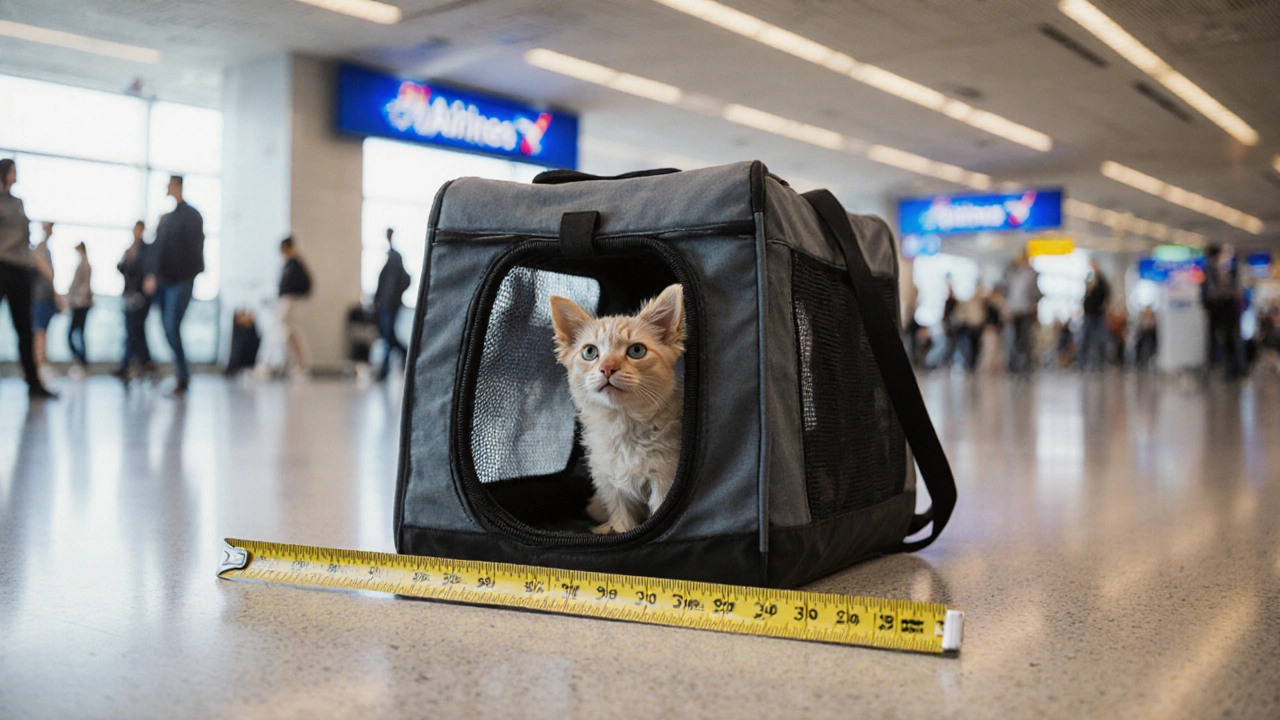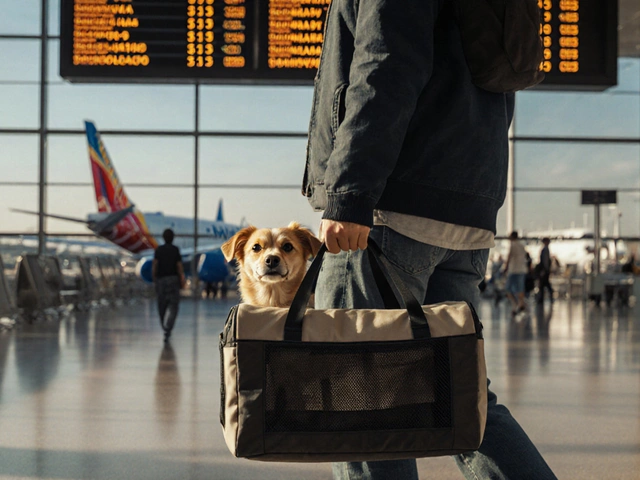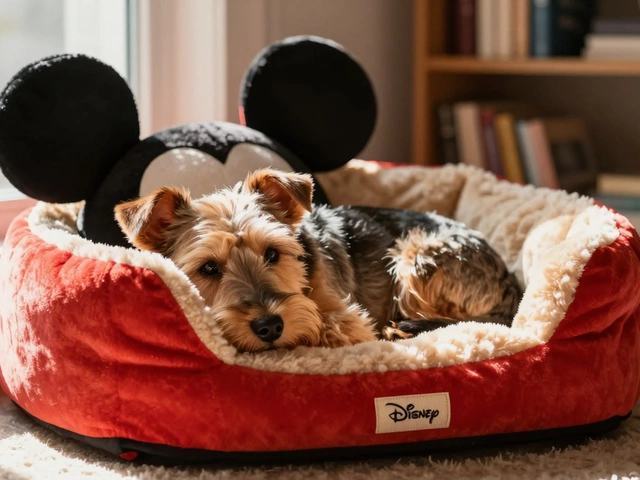Pet Carrier Size Checker
Check Your Pet Carrier
Enter your carrier's dimensions and pet weight to see if it meets airline requirements for cabin travel
| Airline | Max Size (inches) | Max Weight (lbs) | Compliant |
|---|
When you’re planning to fly with your dog or cat, one question keeps coming up: What is the largest pet carrier allowed on a plane? It’s not as simple as picking the biggest carrier that fits in your closet. Airlines have strict rules-and they’re not always the same. If you get this wrong, you could end up stuck at the gate, paying hundreds in fees, or worse, having your pet sent as cargo. This isn’t about guesswork. It’s about knowing exactly what fits, what’s allowed, and which airlines give you the most room.
There’s No Single Answer-It Depends on the Airline
You can’t just Google "largest pet carrier" and get one size that works everywhere. Each airline sets its own rules for carry-on pet carriers. The biggest mistake pet owners make? Assuming what works for Delta works for United or Southwest. It doesn’t. Even within the same airline, rules can change by route or aircraft type.Most major U.S. airlines allow a pet carrier that fits under the seat in front of you. That means the carrier must be soft-sided, flexible, and measured by its dimensions when laid flat, not when standing up. The typical maximum size across airlines is around 18 x 11 x 11 inches (46 x 28 x 28 cm). But some airlines go bigger.
For example, Alaska Airlines allows carriers up to 19 x 13 x 9 inches (48 x 33 x 23 cm). That’s an extra inch in length and depth. JetBlue lets you bring a carrier up to 17 x 12 x 8.5 inches-slightly smaller, but still within the common range. Southwest? They’re more flexible. Their policy says the carrier must fit under the seat, but they don’t list exact numbers. That means if it fits, it’s usually allowed. But don’t test them.
Why Size Limits Exist (And Why You Can’t Just Buy a Bigger Carrier)
Airlines don’t make these rules to be annoying. It’s about safety and space. The space under an airplane seat is tight-usually no more than 10 to 12 inches of vertical clearance. If your carrier is too tall, it blocks the seat in front of you, prevents the person from reclining, or gets caught in the aisle during turbulence. That’s a liability.Also, airlines limit the number of pets per flight. Most allow only 2-3 pets in the cabin per aircraft. If you bring a carrier that’s too big, you’re taking up space meant for a human passenger’s bag. That’s why they measure the carrier in the exact position it will sit: flat on the floor, with the wheels or handles tucked in.
There’s another reason: weight. Even if your carrier fits, the combined weight of your pet and carrier can’t exceed 20 pounds (9 kg) on most airlines. A large carrier filled with bedding, water, and a 15-pound dog? That’s already at the limit. A 25-pound dog? You’re not flying in the cabin. Period.
Soft-Sided Is the Only Option for Carry-On
Hard-sided carriers are almost never allowed as carry-on pets. Why? They don’t conform to the shape of the space under the seat. Even if it’s the right size, a rigid box can’t be squeezed in without blocking the aisle or damaging the seat.Soft-sided carriers are flexible. They can bend, fold slightly, and slide under the seat. Airlines require them to be waterproof, well-ventilated, and escape-proof. Look for carriers with mesh panels on at least three sides. A zipper that’s easy to open and close from the outside is a must. You’ll need to be able to reach in and calm your pet during boarding.
Popular brands like Sherpa, Petmate, and Sleepypod make carriers that meet these standards. The Sherpa Deluxe, for example, measures 17 x 11 x 11 inches and weighs under 2 pounds empty. It’s been used on over 500,000 flights. That’s not luck-it’s design.
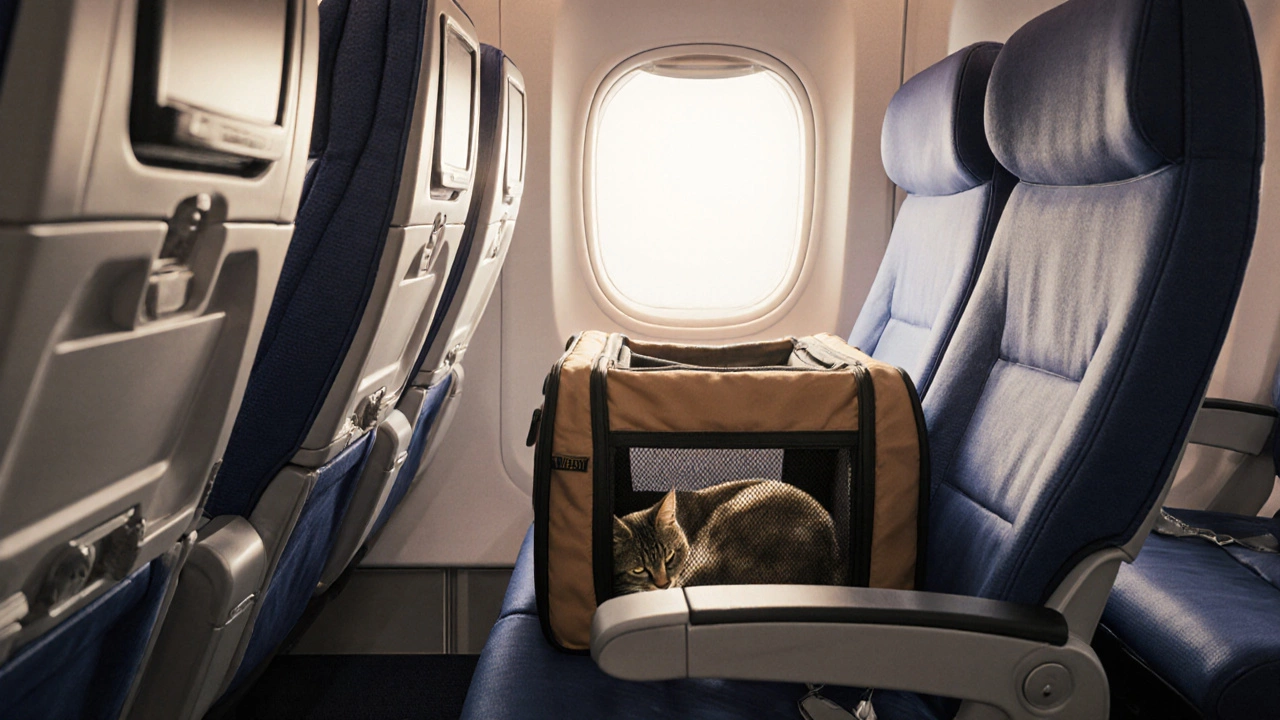
What Happens If Your Carrier Is Too Big?
You’ll find out at the gate. That’s when gate agents check every pet carrier. If yours is too big, you have three choices:- Check it as luggage (if allowed by airline policy and your pet’s size)
- Pay a fee to upgrade to a larger carrier (rare, and usually not possible)
- Leave your pet behind and fly solo
Most airlines won’t let you check a carrier as baggage unless your pet weighs over 20 pounds. So if you have a 16-pound cat in a 19-inch carrier, you’re stuck. You can’t check it, and you can’t bring it in. That’s why measuring ahead of time is critical.
Pro tip: Bring a ruler or tape measure. Measure your carrier’s length, width, and height while it’s lying flat on the ground. Then compare it to the airline’s published limits. If you’re within 0.5 inches, you’re probably fine. If you’re over, don’t risk it.
Which Airlines Let You Fly With the Largest Pet Carriers?
Here’s a clear breakdown of the top U.S. airlines and their maximum carry-on pet carrier dimensions:| Airline | Max Dimensions (inches) | Max Dimensions (cm) | Max Weight (Pet + Carrier) |
|---|---|---|---|
| Alaska Airlines | 19 x 13 x 9 | 48 x 33 x 23 | 20 lb (9 kg) |
| American Airlines | 18 x 11 x 11 | 46 x 28 x 28 | 20 lb (9 kg) |
| Delta Air Lines | 18 x 11 x 11 | 46 x 28 x 28 | 20 lb (9 kg) |
| JetBlue | 17 x 12 x 8.5 | 43 x 30 x 22 | 20 lb (9 kg) |
| Southwest Airlines | No published size (must fit under seat) | N/A | 20 lb (9 kg) |
| United Airlines | 18 x 11 x 11 | 46 x 28 x 28 | 20 lb (9 kg) |
| Hawaiian Airlines | 17 x 10 x 9 | 43 x 25 x 23 | 20 lb (9 kg) |
Alaska Airlines is the clear winner if you need the most space. Their 19-inch length gives you an extra inch over everyone else. That might not sound like much, but for a medium-sized cat or a small dog like a French Bulldog or Corgi, that extra inch means the difference between flying in the cabin or being stuck in cargo.
What About International Flights?
International rules are stricter. The European Union, for example, requires all pet carriers to be IATA-compliant. That means even if your carrier fits on a U.S. flight, it might not meet EU standards. Some countries require hard-sided carriers for entry, even if you’re just transiting.British Airways allows carriers up to 17 x 12 x 8 inches. Lufthansa? 18 x 11 x 11 inches, but only if your pet weighs under 17 pounds. Air Canada? 18 x 11 x 11 inches, same as U.S. airlines-but they require a health certificate for every pet, no exceptions.
If you’re flying overseas, always check the airline’s website and the destination country’s pet import rules. Don’t assume what works in the U.S. works abroad. One wrong step and your pet could be quarantined for weeks.
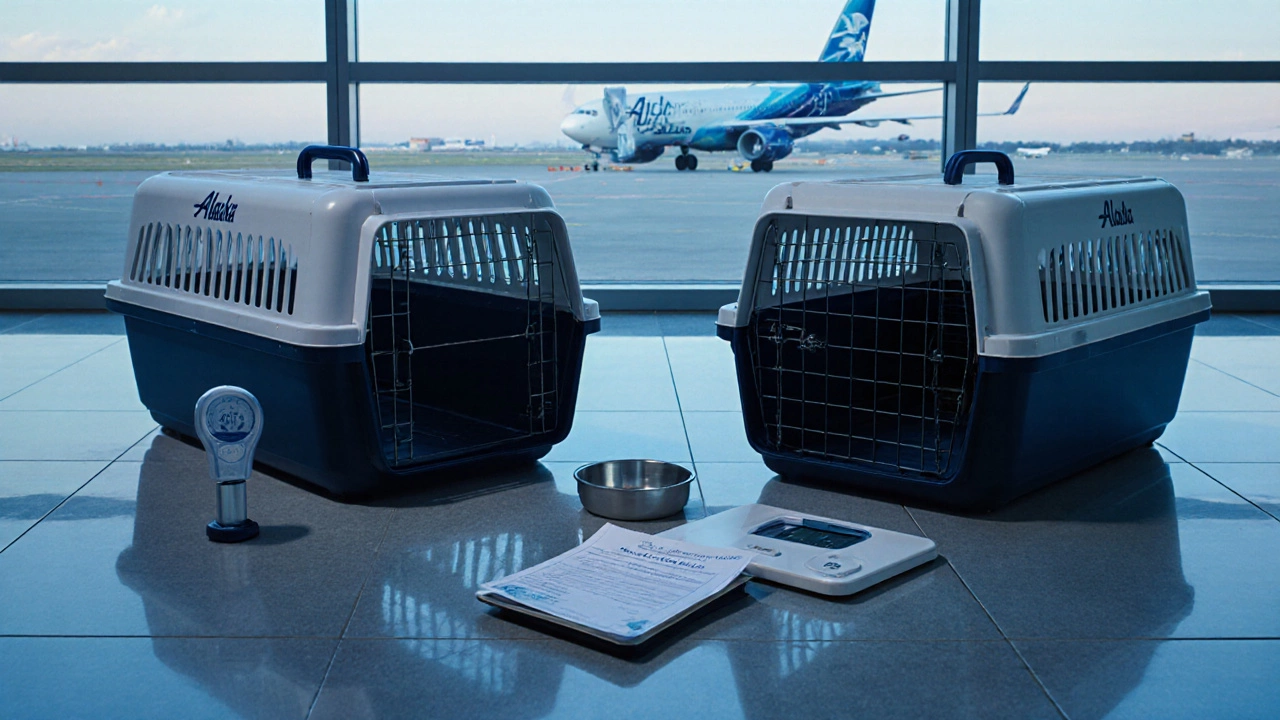
How to Measure Your Carrier Correctly
Here’s how to make sure your carrier passes inspection:- Place the carrier flat on the floor, with the opening facing up.
- Measure the length from front to back (the longest side).
- Measure the width from side to side.
- Measure the height from bottom to top.
- Make sure the wheels, handles, and zippers are fully retracted or tucked in.
- Compare your numbers to the airline’s published limits.
Pro tip: Take a photo of your carrier lying flat with a ruler next to it. Save it on your phone. If a gate agent questions it, show them the picture. It’s saved more than one pet’s trip.
What If Your Pet Is Too Big for the Cabin?
If your dog weighs more than 20 pounds, you have two real options:- Ship your pet as checked baggage (if the airline allows it)
- Use a professional pet transport service
Checked baggage is cheaper than cargo, but it’s still risky. Your pet travels in a pressurized, temperature-controlled area-but not in the cabin. That means no visibility, no comfort, and no reassurance. Some airlines like Delta and United allow pets up to 100 pounds as checked baggage, but only on certain routes.
Professional pet transport companies (like PetRelocation or PetAirways) handle everything: paperwork, customs, temperature-controlled vehicles, and even airport pickup. It costs $1,000-$3,000, depending on distance, but it’s the safest way to move a large dog across the country or overseas.
Final Checklist Before You Fly
Don’t wing it. Use this checklist:- Confirm your airline’s pet carrier size limit (don’t rely on memory)
- Measure your carrier in the exact position it will sit under the seat
- Ensure your pet’s weight (including carrier) is under 20 pounds
- Choose a soft-sided, ventilated, escape-proof carrier
- Book your pet’s spot early-only 2-3 are allowed per flight
- Get a health certificate from your vet (required by most airlines)
- Label the carrier with your name, phone, and destination
- Bring a collapsible water bowl and a small treat for calming
Flying with your pet isn’t impossible. But it’s not easy either. The largest pet carrier allowed on a plane isn’t about size-it’s about compliance. Know the rules. Measure twice. Fly once.
Can I bring a hard-sided pet carrier on a plane as carry-on?
Almost never. Airlines require soft-sided carriers because they can fit under the seat without blocking space or damaging the aircraft. Hard-sided carriers are only allowed as checked baggage or cargo, and even then, they must meet IATA standards. Stick to soft-sided for cabin travel.
Is there a weight limit for the pet carrier itself?
Yes. Most airlines limit the total weight of your pet plus carrier to 20 pounds (9 kg). The carrier itself usually weighs 2-4 pounds, so your pet can’t be heavier than 16-18 pounds. If your pet is heavier, you’ll need to check it as baggage or use a pet transport service.
Can I buy a larger carrier and just check it as luggage?
You can check a larger carrier as baggage only if your pet weighs under 100 pounds and the airline allows it. But you’ll pay extra-usually $150-$250 each way-and your pet won’t be with you in the cabin. It’s safer and less stressful to fly with your pet in the cabin if possible.
Do all airlines charge the same fee for in-cabin pets?
No. Fees range from $95 to $200 per flight, depending on the airline. Alaska Airlines charges $100 each way. United and Delta charge $125. Southwest charges $95. Always check the airline’s website for current fees before booking.
What if my pet is a service animal?
Service animals are not subject to size or weight limits. They can travel in the cabin without a carrier, as long as they’re trained and under control. Emotional support animals are no longer protected under federal law in the U.S. and are treated like regular pets. Always carry documentation for service animals.

